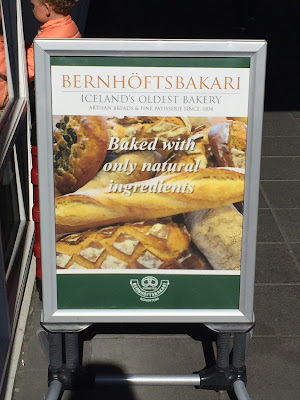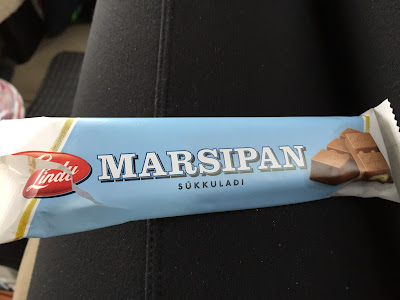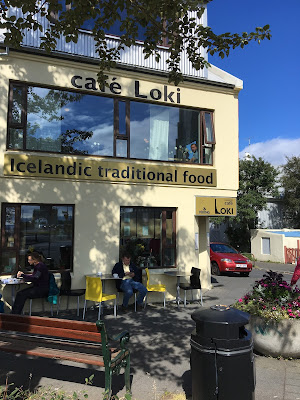After stepping off our redeye from JFK into the bright Icelandic morning, our guide Fridrik was kind enough to suggest that we stop at a nearby coffee shop for a quick snack. This place was in a strip mall and resembled a basic Starbucks, but they had tasty (and messy) sweets to offer, like this saetabraudslengja, which loosely translates to "sweet throw bread" (my apologies to any Iceland natives reading this as I butcher your proud language). It provided the perfect jolt of frosting and sugar to start our long day of sightseeing.
Good desserts are apparently a prerequisite to surviving long stretches of Arctic gloom - most dining places we visited in Iceland had them. We ended our evening hotel meal in Djupivogur (the one with the unusual seafood pizza) on a high note with a sneak trip up the street to a fast food emporium with a small dessert case featuring a sort-of cheesecake and pie hybrid (top item) and a nice rhubarb-berry crisp.
I have to give credit to Paris-based pastry chef and author David Lebovitz for his very comprehensive (and very helpful) posting on prominent Reykjavik bakeries such as Bernhoftsbakari, which has been slinging out dough in various forms since 1834.
The bakery's serbakad vinarbraud (lower left in the photo below) is a custard-filled sweet bread with a smidgeon of chocolate and vanilla icing that left us weak-kneed.
Another Lebovitz entry was Sandholt, located on the main tourist drag a few blocks from our Reykjavik hotel. We had a little trouble making our selections here due to confusing signage, but the apple tartlet and chocolate hazelnut fudge brownie we chose were beyond excellent.
In general, the natives have quite a sweet tooth, especially for licorice (Atlas Obscura has a good article here about Iceland's predilection for licorice). It's not difficult to go into any gas station (N1 is by far the most prevalent chain, standing in as grocery store and de facto community center for some of the more remote locales) and find licorice in multiple forms, such as covered in chocolate and paired with marzipan.
You can also get the chocolate/marzipan combo without licorice. Mrs. H. enjoyed most of the Icelandic candy we sampled, but I'm more of a purist (I missed my dark chocolate with nuts).
Ice cream bars are also very popular. One night after dinner, the missus and I set out to discover the most obscure-sounding ice cream confections in the gift shop next to our hotel. She selected a bar "with Daim" (which turned out to be toffee pieces), while my ice cream contained "salmiak", giving it a flavor that was, well, interesting, if not a bit on the spicy side. Our guide later told me that salmiak is like white pepper, and further investigation yielded that it's actually a combination of licorice with ammonium chloride, an oddball melding of salt and astringency favored by some in Scandinavian countries (the flames on the package should have given me a clue).
I found the local orange soda (Appelsin) to be much more pleasant.
With such unspoiled natural resources and vast amounts of glacial water, one would think that Iceland would produce some good beverages (especially of the alcoholic variety), and you'd be correct.
Visitors to Iceland's largest glacier (Vatnajokull) can indulge in a beer (made by Olvisholt Brewery) brewed from its slushy snowmelt infused with Arctic herbs such as thyme. Another tasty brew is Einstok's Pale Ale, which is more widely distributed (in fact, I'm pretty sure you can find it in the States if you're persistent enough). Amazingly, beer was outlawed here from 1915 until 1989, so it's encouraging to see the development of a fine brewing industry in these parts.
One thing that surpasses the average Icelander's love of beer is his/her love of dried fish snacks. The fish is usually cod (but can be others) and can be found in retails outlets everywhere, as ubiquitous as potato chips.
The texture of these snacks is a little tougher than I was expecting (more chewy than crunchy), similar to chicharrones (dried pork skin commonly eaten in Hispanic cultures), for example. The locals sometimes slather butter on the strips to help make them a bit more palatable, but that didn't do much for me.
Perhaps the tastiest snack we encountered on our trip was served in one of the most remote regions, the eastern highlands, where harsh weather conditions create hardships nearly year-round for anyone brave enough to establish a settlement there. This particular small farm was operated by the same family for a hundred years and was located several miles from the nearest paved road.
The family living here now runs the farm as a museum, coffee shop, and tourist attraction, serving plates of little pancakes (just like the sign says) served with clotted cream and a delectable rhubarb jam.
Slightly larger, but no less remote, is the nearby town (and I use the term loosely in this case) of Modrudalur, which has a church, a few houses, and a small restaurant with what may very well be the world's highest lunch prices.
This bowl of Iceland moss soup (which did actually have some moss in it) was about $20, giving us a tab of close to $50 when we added a second bowl of soup (vegetable, if I remember correctly) and one bottle of Kaldi beer.
Soup is a common lunch item in Iceland and is usually much more budget-friendly. This bowl of Icelandic meat soup (featuring tender chunks of mutton) at a different cafe was delicious and is the most popular of the country's soup varieties.
With the booming tourist trade, food trucks (both mobile and fixed) are beginning to pop up at some of the attractions. This one featured local langoustine (lobster) chopped up, tossed with some blackening spices (such as pepper), grilled hot to order, and served on a roll with a slathering of remoulade, a nice departure from the cold New England-style lobster roll we're more used to in America.
As an island with a dearth of native fauna, seafood is an acceptable meal any time of day, including breakfast. Like most places in northern Europe, pickled herring (in many different sauces) and smoked salmon graces many a plate in the early morning, along with a slab of dark bread for good measure.
Icelanders both young and old are fond of a daily shot of cod liver oil for its reputed health properties. At first, I thought this was alcohol until our guide set me straight. No hotel breakfast buffet is complete without it.
Using wood (and sometimes sheep dung) smoke to preserve meat and fish is still a traditional food preparation technique in rural areas of the country. This farm sells trout and lamb fillets that are smoked in huts onsite, then vacuum sealed to preserve freshness. Mrs. Hackknife and I purchased some of each and transported it with us all the way to Reykjavik, where we enjoyed it in our hotel room one Friday evening. The smoky flavor was quite robust and almost overpowering (I had to tightly package up the remnants in a plastic bag so as not to stink up the place).
Our dinner in Akureyri (Iceland's second largest city) was a little less pungent, but no less tasty as we opted for a fast casual meal at the town's favorite chippy shack.
I can't say for sure what type of fish was being fried up that night (I'm guessing cod) - no matter as it was the equal of any I've had in the British Isles, plus the fries and cole slaw were also top shelf.
Akureyri was also where we noticed our first Icelandic hot dog stand (prior to this, we were seeing wieners mostly just at N1 stations). The Scandinavian countries (especially Denmark and Iceland) have a real affinity for hot dogs, some of which are served with unusual toppings. The alleged regional specialty of this "pylsuvagninn" (or "hot dog wagon") was a dog with four sauces (remoulade, cocktail sauce, brown mustard, and ketchup), raw onions, and cooked sweet red cabbage.
This combo sounded like a huge mess on a bun (although being a native Chicagoan, I know something about dragging a dog through the garden), but the ingredients worked wonderfully together and provided a great digestive aid for my fish and chips (along with an antacid a little later on).
Of course, no trip to Iceland would be complete without a visit to its most famous hot dog stand, Baejarins Beztu Pylsur (or "The Town's Best Sausages") in Reykjavik, with a staff of 2 (that's about all there's room for in that tiny hut) cranking out what many connoisseurs consider to be one of the planet's best hot dogs since the 1930s.
The line is usually long (I'm told they sell over 1,000 dogs a day at peak times), but moves quickly as the menu choices are few (hot dogs and soda). The fully loaded lamb, pork, and beef wieners here are topped with ketchup, remoulade, a very distinct sweet brown mustard (which I would have brought home had I been able to procure some), and onion two ways (raw and crispy fried). I wouldn't go so far as to say that this was the best hot dog I've ever had, but it definitely makes the top 10 and I can see how one might become addicted.
If all this talk of fried fish and hot dogs makes you yearn for more traditional Icelandic fare, you have to stop in at Cafe Loki (all the guidebooks and David Lebovitz agree), located up the hill in Reykjavik across the square from the country's most famous church, Hallgrimskirkja.
If you eat in the upstairs dining room, you'll be greeted by a giant mural depicting fantastical scenes from Iceland's literary sagas (not unlike a Dungeons & Dragons fever dream).
Medieval psychedelia aside, customers can order combination plates of some of Iceland's iconic dishes. I opted for Plate #1, with mashed fish and smoked trout (both on rye bread), sheep-head jelly (maybe my most favorite dish of all) atop a kick-ass flatbread, creamy bean salad, and mashed turnip.
Mrs. H. took things one step further and ordered Plate #2, also with smoked trout and mashed fish, plus smoked lamb on flatbread, dried fish, and a few cubes of fermented shark, a delicacy that used to be eaten by the older generation of Icelanders, but is now sold mostly to tourists with adventurous palates. Our server warned us against smelling the shark meat before popping it into our mouths - obviously, I did so anyway (it reeked of ammonia) and I can't say I really enjoyed the flavor too much.
The cafe's famous rye bread ice cream with rhubarb syrup and whipped cream went down significantly easier. I'll pass on the shark in favor of a pint of this next time out...





































